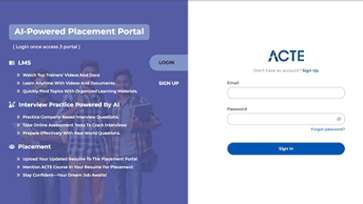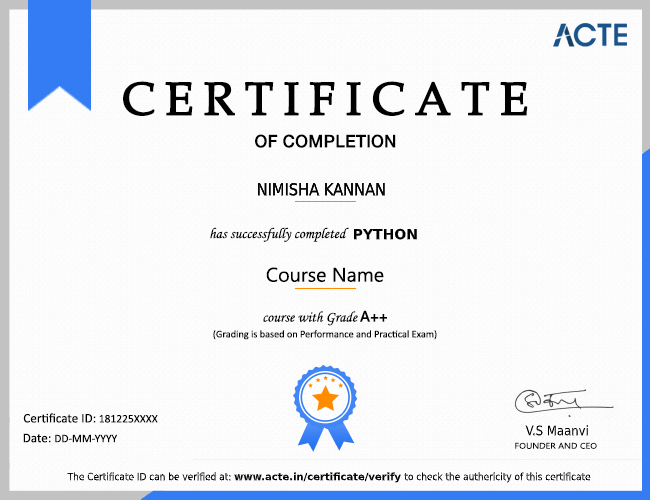About Solaris Online Training Course
ACTE provides students with the skills necessary to administer Sun systems running Solaris 10 in a network environment. Learners will gain the knowledge necessary to maintain, configure and troubleshoot the Network File System (NFS); Setup custom Jumpstart environment; configure the Network Information Service (NIS) environment and manage Solaris Zones. our furthermore online course is a much needed one for the aspirants out there in the market. We have course details and furthermore some demo sessions for you to try out.
Benefits
Solaris also supported Sun Rays, but they became available on Linux too. Focused enhancements across CPU, memory, file system, I/O, networking, and security deliver the best database, middleware, and application performance for Oracle workloads. That made it popular with schools, governments, enterprises, and other large organizations, which used Solaris as a platform to develop their own proprietary software -- software which still exists today. In short, Sun Solaris is used to run legacy applications built for Solaris.
Solaris is the best enterprise operating system for Oracle Database and Java applications. Focused enhancements across CPU, memory, file system, I/O, networking, and security deliver the best database, middleware, and application performance for Oracle workloads.
-
- Administrative commands – The cryptoadm command provides a list subcommand to list the available providers and their capabilities. Ordinary users can run the cryptoadm list and the cryptoadm --help commands.
All other cryptoadm subcommands require you to assume a role that includes the Crypto Management rights profile, or to become superuser. Subcommands such as disable, install, and uninstall are available for administering the framework. For more information, see the cryptoadm(1M) man page.
The svcadm command is used to manage the kcfd daemon, and to refresh cryptographic policy in the kernel. For more information, see the svcadm(1M) man page.
- User-level commands – The digest and mac commands provide file integrity services. The encrypt and decrypt commands protect files from eavesdropping. To use these commands, see Protecting Files With the Solaris Cryptographic Framework (Task Map).
- Binary signatures for third-party providers – The elfsign command enables third parties to sign binaries for use within the framework. Binaries that can be added to the framework are PKCS #11 libraries, kernel algorithm modules, and hardware device drivers. To use the elfsign command, see Appendix F, Packaging and Signing Cryptographic Providers, in Solaris Security for Developers Guide.
- To reboot the system to the state that is defined by the initdefault entry in the /etc/inittab file, type the following command: # init 6.
- To reboot the system to a multiuser state, type the following command: # init 2.
We are happy and proud to say that we have strong relationship with over 700+ small, mid-sized and MNCs. Many of these companies have openings for Solaris analyst. Moreover, we have a very active placement cell that provides 100% placement assistance to our students. The cell also contributes by training students in mock interviews and discussions even after the course completion.
Solaris Application Programming (Solaris Series) eBook: Gove, Darryl: and optimization or an experienced developer searching for the most efficient ways .In addition, you will learn how to use the rich set of developer tools to identify
There is no prerequisite to learn.Anyone can learn.
Solaris 11.4 contains support for the C11 programming language standard: "ISO/IEC 9899:2011 Information technology - Programming languages - C". The C11 standard is a compatible revision of the C99 standard. Historically, the C programming language standard has been part of the Single UNIX Specification.
Our courseware is designed to give a hands-on approach to the students in Solaris . The course is made up of theoretical classes that teach the basics of each module followed by high-intensity practical sessions reflecting the current challenges and needs of the industry that will demand the students’ time and commitment.
Among the many advantages the Solaris operating environment provides are portability, scalability, interoperability, and compatibility.
That made it popular with schools, governments, enterprises, and other large organizations, which used Solaris as a platform to develop their own proprietary software - software which still exists today. In short, Solaris is used to run legacy applications built for Solaris.
- Delivers near-linear performance gains: 92 percent for database applications, and 88 percent for Java platform applications.
- Speeds up Web workload processing by 47 percent on SPARC platforms with four processors over Solaris 9, and more than 80 percent over Solaris 8.
- Increases Web workloads on x86 architecture systems, delivering up to 43 percent improvement over Solaris 9 with two processors.
- Increases Secure Sockets Layer (SSL) Data Encryption Standard (DES) performance by 77 percent; performance for 3DES increases by 130 percent over Solaris 9.
- Improves performance up to 38 percent for Solaris 10 over Linux on dual-processor Sun Fire systems from Oracle.
- Outperforms commercial distributions of Linux on x64 systems.
- Sets performance and price/performance world records on multiple platforms.
Sun Considering Solaris For Power
- Solaris is SunOS packaged with a number of additional tools and a graphical user interface (GUI) environment. Since Sun Microsystems did not offer Solaris until SunOS 4, SunOS and Solaris have different version conventions (e.g., Solaris 1 includes SunOS 4, while Solaris 2 includes SunOS 5).
- To further confuse the naming scheme, Sun now refers to Solaris by just its point release (e.g., Solaris 7, 8, or 9 instead of 2.7, 2.8, or 2.9).
- Sun Microsystems Inc. is considering a port of its Solaris version of the Unix operating system to two new processor architectures designed by chip rivals IBM Corp. and Intel Corp., a company executive said Tuesday.
- The SunOS name is usually only used to refer to versions 1.0 to 4.1.4, which were based on BSD, while versions 5.0 and later are based on UNIX System V Release 4, and are marketed under the brand name Solaris.
- The comments came during Sun’s quarterly earnings conference call with press and financial analysts on Tuesday, when Sun president and chief operating officer Jonathan Schwartz mentioned IBM’s Power and Intel’s Itanium processors while contrasting Sun’s Unix strategy to that of other Unix vendors.
“Unlike IBM, who obviously is really narrowly deploying AIX onto one of their system families, we’ve also begun looking at delivering Solaris on Power, as well as Solaris on Itanium, as ways of really driving incremental volume,” Schwartz said.
Schwartz was quickly cut off by Sun’s chief executive officer, Scott McNealy, who said, “That’s not a product announcement,” and Sun representatives declined to comment on when, if ever, such products might be released.
- The idea of running Solaris on Intel’s Itanium processors — which compete with Sun’s own UltraSparc chips — is not a new one.
- In 2001, Sun actually completed a port of Solaris to Itanium, which was never brought to market because of low demand for Itanium systems, according to Sun.
- A year after the Itanium port, Sun also terminated support for Solaris on Intel’s other chip architecture, x86, but that decision was reversed several months later after Solaris x86 users blasted the move.
- Now, judging from Schwartz’s comments, the company is having second thoughts about the Itanium port.
- A Solaris port to IBM’s Power architecture would be a surprise, said Nathan Brookwood, principal with industry research firm Insight64, in Saratoga, Calif.
“The question is, would people purchasing Power platforms from IBM be interested in Solaris as opposed to either Linux or AIX, and that doesn’t seem like a real strong likelihood,” he said.
- Though Sun has promised to release Solaris under an open-source license, Sun will have a nearly impossible task in convincing independent software vendors and hardware vendors such as IBM or Hewlett-Packard Co. to provide technical support, performance tuning or marketing resources for Solaris on these new platforms when they have already committed to Linux, Brookwood said.
“Solaris is a Sun product, and therefore the likelihood that an IBM is going to put any effort into making Solaris run better on Power systems or that HP would put any effort into making it run better on Itanium systems is pretty close to zero,” he said. “One of the big issues is not the open-sourcing. It is the vendor neutrality.”
- Still, Sun has made some headway recently with Solaris on x86. The company added 15 Solaris original equipment manufacturers and 54 independent software vendors in the last quarter, and the Sun has now certified 220 systems — including those made by Dell Inc., HP, and IBM — as compatible with Solaris, Schwartz said.
“Solaris is broader than simply Sun’s hardware,” he said. We are very comfortable with our operating system strategy and the flexibility it gives us in creating disruptive pricing models, like subscriptions to an operating system that include free hardware.
Show More































